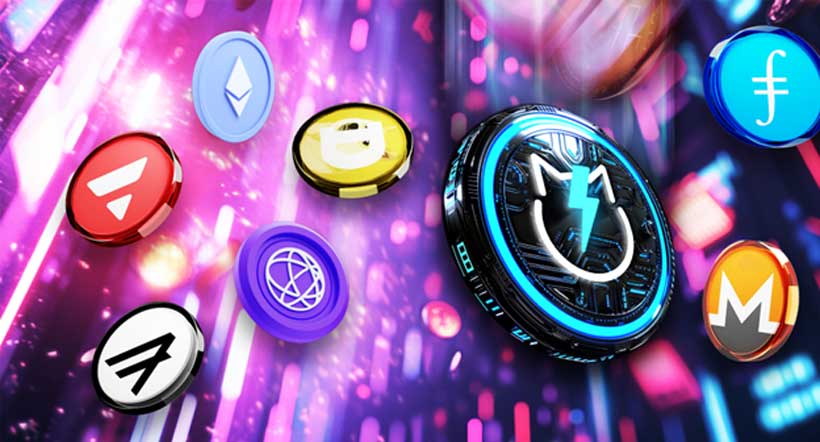Introduction
The cryptocurrency landscape is evolving faster than ever. While Bitcoin and Ethereum continue to dominate headlines, a new generation of altcoins is emerging—each offering unique use cases, innovative technology, and serious growth potential. As we head into 2025, savvy investors and blockchain enthusiasts are looking beyond the usual suspects and exploring the next wave of contenders.
But with thousands of coins on the market, how do you separate the signal from the noise? That’s where we come in. Whether you’re a crypto beginner or a seasoned trader, this guide will walk you through 10 of the most promising altcoins to keep on your radar in 2025.
1. Solana (SOL)
Once called the “Ethereum killer,” Solana has rebounded from its earlier struggles with network outages. With blazing-fast transaction speeds (up to 65,000 TPS) and ultra-low fees, it’s become the go-to platform for DeFi projects, NFTs, and even mobile crypto apps.
In 2025, expect Solana to benefit from stronger infrastructure, growing developer adoption, and new use cases that position it as a true Ethereum alternative—not just in theory, but in practice.
2. Arbitrum (ARB)
Built as a Layer 2 scaling solution for Ethereum, Arbitrum brings cheaper and faster transactions without sacrificing security. As Ethereum continues its rollup-centric roadmap, Arbitrum is becoming a key piece of the puzzle.
DeFi platforms, gaming apps, and Web3 tools are increasingly migrating to Arbitrum for efficiency. If Ethereum dominates Web3, Arbitrum might be the infrastructure quietly powering it all.
3. Render (RNDR)
Ever tried rendering 3D graphics or virtual environments? It takes a lot of computing power. Render Network decentralizes this process by allowing users to rent GPU power from others in exchange for RNDR tokens.
As AI, metaverse platforms, and virtual production studios grow, Render’s unique approach to distributed computing could become foundational tech—and its token, a hot commodity.
4. Chainlink (LINK)
For blockchain to be truly useful, smart contracts need real-world data—from weather conditions to asset prices. That’s where Chainlink shines. It’s the top decentralized oracle network and has already partnered with Google Cloud, SWIFT, and dozens of DeFi platforms.
With Cross-Chain Interoperability Protocol (CCIP) gaining traction, Chainlink is well-positioned to unify siloed blockchain ecosystems in 2025.
5. Sui (SUI)
Developed by ex-Meta engineers, Sui is a relatively new Layer 1 blockchain focused on speed, scalability, and developer-friendliness. Unlike most chains, it uses a unique “object-centric” model for faster, parallel execution of transactions.
Gaming, DeFi, and social dApps are already experimenting on Sui, and its developer ecosystem is growing rapidly. If you’re hunting for early-stage gems, Sui deserves a close look.
6. Injective (INJ)
This one’s tailor-made for traders. Injective is a Layer 1 blockchain optimized for DeFi and decentralized derivatives trading. It supports on-chain order books, advanced trading tools, and cross-chain asset transfers.
With increasing scrutiny on centralized exchanges, decentralized platforms like Injective could surge in 2025—especially if derivatives become crypto’s next big wave.
7. Celestia (TIA)
Think of Celestia as the “modular blockchain” revolution. Instead of trying to do everything (like Ethereum), it focuses solely on data availability—a critical piece in the blockchain scalability trilemma.
By decoupling consensus from execution, Celestia enables other chains to launch more efficiently. It’s early days, but the modular approach could be the future, and TIA tokens power it all.
8. Avalanche (AVAX)
After a quiet 2023, Avalanche is back with new partnerships (including Amazon Web Services) and a push toward subnet deployment. Subnets allow tailored blockchains with customizable rules, making Avalanche a favorite for enterprise blockchain solutions.
As real-world use cases grow—think banking, gaming, and supply chain—AVAX could quietly climb the ranks.
9. Kaspa (KAS)
Bitcoin is slow. Ethereum is congested. Enter Kaspa—a PoW (Proof-of-Work) coin that combines speed with decentralization. Its blockDAG architecture allows multiple blocks to be confirmed per second, solving the scalability issues of older chains.
It’s gaining traction among miners and decentralization advocates. If energy-efficient PoW sees a revival, KAS could be at the forefront.
10. Optimism (OP)
Another Ethereum Layer 2 making serious waves, Optimism is focused on reducing gas fees and scaling dApps using optimistic rollups. It’s also aligned closely with Ethereum’s roadmap and supports retroactive public goods funding—a unique approach to ecosystem growth.
In 2025, as Ethereum scales, OP could benefit significantly, both in terms of user adoption and value appreciation.
FAQs
What is an Altcoin?
An altcoin is any cryptocurrency that isn’t Bitcoin. This includes coins like Ethereum, Solana, and newer tokens launched on various blockchain platforms.
How do I Buy Altcoins?
You can buy altcoins on major exchanges like Coinbase, Binance, Kraken, or through decentralized exchanges (DEXs) like Uniswap and PancakeSwap. Always use secure wallets and enable 2FA for extra protection.
Are Altcoins Risky?
Yes. Altcoins are highly volatile and speculative. While they offer high upside potential, they also come with significant risk. Never invest more than you’re willing to lose, and always do your own research (DYOR).
Can Altcoins Outperform Bitcoin in 2025?
Historically, some altcoins have outperformed Bitcoin during bull markets (this is known as “altseason”). However, they’re also more prone to losses in downturns. Diversification is key.
Conclusion
The crypto market in 2025 will be more mature, more regulated, and more innovative than ever before. While Bitcoin and Ethereum will likely remain dominant, the real growth stories may come from altcoins that are solving niche problems, pushing technological boundaries, or enabling the next wave of decentralized applications.
From Solana’s speed to Chainlink’s oracles, and Render’s decentralized GPU power to Kaspa’s blockDAG architecture, each of the altcoins listed here brings something unique to the table. Whether you’re investing or just curious, keep a close eye on these projects—they might just shape the future of blockchain as we know it.
Remember: the best altcoin investments aren’t about hype—they’re about utility, vision, and execution. So choose wisely, stay informed, and prepare for an exciting 2025 in crypto.

